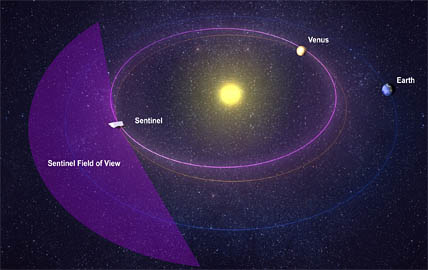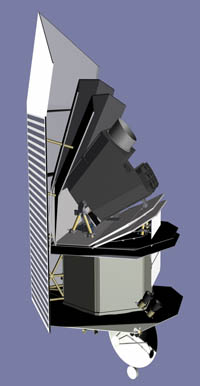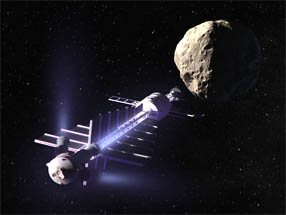A private nonprofit group led by former astronauts, spacecraft designers, and asteroid specialists has proposed a spacecraft to find a half million asteroids in Earth-crossing orbits and provide advance warning of impact threats.
It seems like just weeks ago that a high-profile group of space entrepreneurs announced plans to track down vast numbers of asteroids in Earth's vicinity. (Oh, wait: it was!)

If private funding can be found, the B612 Foundation plans to launch its Sentinel spacecraft in 2017 to scan for near-Earth asteroids from a Venus-like orbit around the Sun. Click on the image for a larger view.
B612 Foundation / Spine Films
Now a second group hopes to blaze its own interplanetary trail in search of near-Earth objects (NEOs). Yesterday the B612 Foundation released details of a spacecraft called Sentinel, which could be launched as early as 2017. Its objective is to find and track a half million asteroids in Earth's vicinity, sweeping up 90% of those with diameters of at least 450 feet (140 m) over its 5½-year mission.
B612, as you literature buffs already know, is the name of the house-size asteroid featured in Antoine de Saint-Exupéry's 1943 novella The Little Prince. Former astronauts Rusty Schweickart and Ed Lu, together with astronomers Clark Chapman and Piet Hut, formed the foundation in 2002 with the goal of protecting Earth from asteroid strikes. The Sentinel team is stacked with A-list space veterans, including program architect Scott Hubbard (former director of NASA's Ames Research Center) and mission director Harold Reitsema (former director for science-mission development at Ball Aerospace). Schweickart and Lu aren't slouches either.
Although the B612 proposal and the one announced in April by Planetary Resources might seem similar, they're not. For one thing, the latter group is looking for accessible asteroids in the hope of mining them for water, platinum, and other valuable resources. But the B612 Foundation is focused on finding big space rocks likely to strike Earth and, assuming they can be found in time, alter their orbits very slightly to avoid collisions.

Roughly the size of a small school bus and weighing 1½ tons, the proposed Sentinel space observatory will feature a 20-inch (0.5-m) telescope, a large thermal-infrared detector array, and extensive shielding from the Sun's heat.
B612 Foundation / Ball Aerospace
Another big difference is in approach. Whereas Planetary Resources intends to build and launch an army of small, low-cost satellites, conceived from scratch using cutting-edge technologies, B612 envisions a single spacecraft that inherits much of its design from previous space observatories like Spitzer Space Telescope and Kepler. Hubbard calls this approach "retirement of the risk," using proven technology to ensure that Sentinel will succeed .
(Don't confuse this concept with the European Space Agency's forthcoming Sentinel satellites, which will study Earth beginning next year.)
The mission approach shows that these guys have done their homework. First, Sentinel would have an elliptical, low-inclination orbit roughly at Venus's distance from the Sun, using a close flyby of that planet to get into place. From there, Reitsema explains, "We can look toward Earth in a dark sky." Moreover, Sentinel will circle the Sun in just 7 months and "lap" Earth every 2.2 years, permitting relatively rapid coverage of the entire sky.
Second, the B612 team plans to equip Sentinel with a 20-inch (0.5-m) telescope and a single detector array recording infrared light from 5 to 10.4 microns. This is key to its success. Asteroids vary in color from medium gray to coal-tar black, which can make them challenging to find in visible light and to estimate their diameters come in all kinds of shades of gray. But they all get warm as they near the Sun — thermally speaking, they literally glow in the dark. And, as Reitsema points out, any variations in surface reflectivity tend to even out in the infrared, which will make diameter estimates more reliable.
OK, I can't resist — here's some more technical detail: About the size of a small school bus, Sentinel will have plenty of shielding to protect it from the Sun's heat (roughly twice the intensity as here). Active cooling will keep its 24-million-pixel detector array chilled to about 40 K (–390°F). The scope's big field of view, 5½° by 2°, will allow it to cover the entire sky every 26 days. Multiple looks at each field means that discovered asteroids can be followed for up to three months — crucial to determining their orbits accurately.

One way to alter the orbit of an Earth-threatening asteroid is to use gravity as a towline between the object and a spacecraft. By firing ion engines to resist the pull of gravity, the spacecraft serves as a "tractor" to slowly alter the asteroid's orbital motion.
Dan Durda
Finally, while Sentinel stands to become the first privately funded interplanetary mission, the B612 Foundation will have some significant partners. Thanks to a Space Act Agreement signed just a few days ago, the space agency has agreed to provide experts to review plans for Sentinel and its mission, track and communicate with the spacecraft once its launched, and use its team of dynamicists to provide orbit calculations and threat assessment.
This all sounds great, but who's gonna pay for it? Lu says Sentinel itself will cost a few hundred million dollars to build, and it'll about that much in addition to pay for the launch vehicle (a SpaceX Falcon 9, as of now) and mission operations. Fundraising is under way, he says.
It makes you wonder why NASA hasn't conjured up a satellite like Sentinel. Well, it has, but it's competing with lots of other great mission proposals for limited dollars. The agency's Jet Propulsion Laboratory has proposed a mission called NEOCam, notes Lindley Johnson, who manages NASA's NEO efforts. The design looks much like the Sentinel concept (or vice versa), but it would operate closer to Earth, at the L1 Lagrange point.
Everyone's on the same page here. We'd all like to know the whereabouts of every threatening space rock out there, but NASA managers like Lindley accept that federal funding (and ground-based telescopes) can't do it all. The B612 Foundation, Lu says, is "dedicated to protecting the long-term future of our planet." That goal seems very reasonable to me.
By the way, the foundation has compiled a solid set of FAQs about B612 and the Sentinel mission.
 2
2
Comments
Gregory E. Garcia
June 29, 2012 at 1:22 pm
I think it's a great Idea, you are right,eventually an asteroid will come close enough to the Earth, however a 5 year mission is not enough. Agreed, funds must be obtained for longer missions, idealy,it should be a permanent mission or different countries can establish a sequence to maintain the missions in space.
Thank you
You must be logged in to post a comment.
Peter Wilson
July 3, 2012 at 12:01 pm
Mankind faces a lot more threats from mankind than from space rocks. Although deflecting an asteroid would be many times easier, at least in principle, than taking on any number of man-made threats, I think we need to get our priorities in line with the actual danger. An asteroid impact is something that could happen. Already happening? Dwindling water and mineral resources, deforestation, fishery collapse, increasing tensions between race, religion and culture, unsustainable population growth, etc. If I knew how to fundraise several hundred million dollars, I would put it towards one of these immediate problems, and ignore the one-in-a-million odds of a major asteroid threat lurking sun-side of the Earth.
You must be logged in to post a comment.
You must be logged in to post a comment.